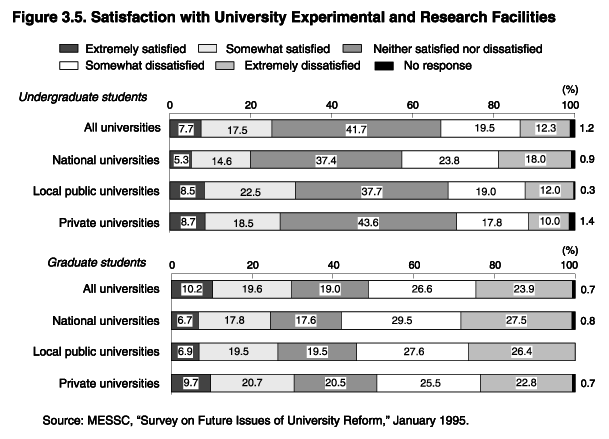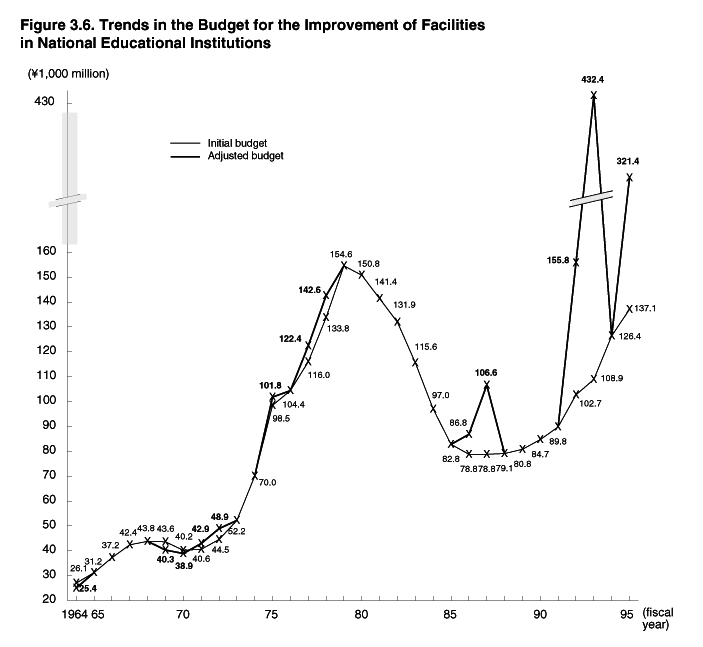| Home > Policy > White Paper, Notice, Announcement > White Paper > JAPANESE GOVERMENT POLICIES IN EDUCATION, SCIENCE, SPORTS AND CULTURE 1995 > Remaking Universities Chapter 3 Section 2 2 | ||
Expansion of the budgetary base for higher education in Japan is an extremely important priority. It is also a basic requirement in order to enable institutions of higher education to fulfill the roles expected of them and to implement reforms based on these institutions' individual characteristics. Despite the difficult fiscal situation facing the Government, gradual progress is being made, but the contribution of public funding to the costs of higher education remains lower in Japan than in Europe and the United States. In view of the role played by higher education in social progress and the improvement of national living standards, it is necessary to consider measures to spread costs across the whole of society by expanding public outlays.
Another priority is the promotion of increased flows of private-sector funds into institutions of higher education, which will encourage self-help efforts by these institutions to improve their educational and research activities and management and will also help them expand their independent financial base. Continued efforts to improve mechanisms for the introduction of private-sector funds are therefore necessary.
The effective utilization of limited financial resources is just as important as efforts to secure funding. The efficient and prioritized allocation of funds is especially important in regard to public outlays. It is essential that institutions of higher education focus on the qualitative improvement of their educational and research activities. The enhancement of fiscal support systems is a vital priority from this perspective.
In recent years not only university officials but also people in industry and other sectors of society have expressed strong concern about the aging and cramped facilities of national institutions of higher education. This problem has been discussed in the National Diet and is frequently the subject of media coverage. In 1995 MESSC commissioned a private-sector research organization to carry out a survey, whose results highlighted strong dissatisfaction among graduate students and others concerning the state of facilities and equipment, including apparatus used in experiments and research. The level of dissatisfaction was especially high at national universities, especially among graduate students ( Figure 3.5 ). There are three reasons for this. First, the severe budgetary difficulties facing the Government since the early 1980s have been reflected in the reduction of funds allocated for facility improvement. Second, buildings constructed during the rapid expansion of higher education in the early 1960s are now aging. Third, facilities are unable to accommodate the increasing diversification and sophistication that have characterized education and research in recent years. Since fiscal 1988 MESSC has been aggressively increasing its facility development budget, including the revision of standards, in order to alleviate the problem of aging and cramped buildings and keep pace with the increasing diversification and sophistication of educational and research activities. Expenditure in this area is recovering, and funds allocated in the initial budget for fiscal 1995 reached 137,100 million yen, or 88.7% of the fiscal 1979 peak. Since fiscal 1992 MESSC has also been endeavoring to secure substantial increases in funds for facility improvement in its supplementary budgets. In fiscal 1992 MESSC initiated special facility improvement projects designed to alleviate the problem of aging and cramped facilities. A special fund was established for this purpose in the Special Account for National Educational Institutions. The projects are being funded by proceeds from the sale of sites vacated after the relocation of national institutions of higher education. The aim is to spend 20,000 million yen a year on systematic efforts to alleviate the aging and overcrowding of facilities. The first five-year plan for this purpose is in progress. Facilities of national institutions of higher education are still far from adequate, however, and it is necessary to continue efforts to secure funding for their improvement. In addition to the improvement of aging facilities, it is necessary to enhance facilities to meet new needs, including disaster prevention measures. Figure 3.5. Satisfaction with University Experimental and Research Facilities
 Figure 3.6. Trends in the Budget for the Improvement of Facilities inNational Educational Institutions
 |
| Back to Top | MEXT HOME |